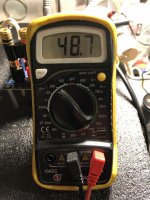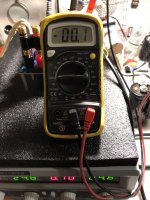I am looking for an easy solution to the pop-off sounds from my speakers when using the TPA3255EVM and Meanwell 350-48 combination.
I haven’t tried this, but it looks pretty simple to implement: http://www.diyaudio.com/forums/class-d/312724-pop-free-startup-shutdown-8.html#post5350461 and follow-up posts
I'm feeling really dense, but where do you connect the negative SE speaker wires for 2 x SE 1 x BTL operation please?
There are two smaller black wire posts for speaker between the big red (ch A&C) and big black (ch B&D) ones. Dead center of the board. Each small ground post is tied to channels A&B, and C&D, respective to their side. As in for SE, you'll share a single ground binding post for both your SE channels.
Last edited:
Wondering about the best choice of power supply for my TPA3250 EVM, please.
But I see that the preferred power supply for ALLO's well regarded TPA3118 amplifier(s) is a very ordinary SMPS, in combination with a capacitance multiplier of ALLO's own design.
Can anyone comment on the relative merits of these two options?
I hesitate to use a cap multiplier in combination with a Connex SMPS, because I think I read that adding more series capacitance to the Connex may interact badly with the Connex's output filtering?
It appears that Connex is a quality product, with a level of filtering beyond garden-variety SMPS units.I am plenty picky about power supplies and just about every other diy project I own uses linear, except for the TPA.
The meanwells are popular but I prefer the connexelectronic smps's.
But I see that the preferred power supply for ALLO's well regarded TPA3118 amplifier(s) is a very ordinary SMPS, in combination with a capacitance multiplier of ALLO's own design.
Can anyone comment on the relative merits of these two options?
I hesitate to use a cap multiplier in combination with a Connex SMPS, because I think I read that adding more series capacitance to the Connex may interact badly with the Connex's output filtering?
When you connect your EVM the Connex sees ~6600uF and when you connect that capmx the Connex sees ~1000uF.
There are two smaller black wire posts for speaker between the big red (ch A&C) and big black (ch B&D) ones. Dead center of the board. Each small ground post is tied to channels A&B, and C&D, respective to their side. As in for SE, you'll share a single ground binding post for both your SE channels.
Not sure what I'm doing wrong here, when I connect both neg speaker wires to the C+D ground post both speakers play left channel only, oddly the A+B only plays the right channel.
When I swap the outputs from my DAC around the above swaps around.
Any help please?
2wice-- that sounds like the input is configured wrong? You are using single ended inputs (i.e. the RCA plugs), correct? And 3 channels of input?
To be sure, you're following the guide on page 8 and the beginning of page 9 from here: http://www.ti.com/lit/ug/slou441/slou441.pdf ?
If you can take a picture of the top and bottom of your board (top over by the input side where the jumpers are, don't need to see the output side) I can probably ensure things are hooked up right.
To be sure, you're following the guide on page 8 and the beginning of page 9 from here: http://www.ti.com/lit/ug/slou441/slou441.pdf ?
If you can take a picture of the top and bottom of your board (top over by the input side where the jumpers are, don't need to see the output side) I can probably ensure things are hooked up right.
Thanks irribeo. But I don't know how to interpret this information - adding a cap multiplier to a Connex is a good idea? Bad idea?When you connect your EVM the Connex sees ~6600uF and when you connect that capmx the Connex sees ~1000uF.
Since I have a cap multiplier already on hand, maybe I will just try it. My only measure of success will be if I hear a better or worse sound.
Thanks, I've changed it back to default 2XBTL to see if all is OK.
I'll swop around and take some pics.
I'll swop around and take some pics.
Thanks irribeo. But I don't know how to interpret this information - adding a cap multiplier to a Connex is a good idea?
What he's saying is if you're worried about capacitance on the output of your switcher you'd better be more worried by a direct connection to your EVM than going via a cap multiplier. Conclusion - a capx is the solution to your problem.
Since I have a cap multiplier already on hand, maybe I will just try it. My only measure of success will be if I hear a better or worse sound.
Can't beat experiment 😀
Thanks, I've changed it back to default 2XBTL to see if all is OK.
I'll swop around and take some pics.
Instead of re-soldering J24 and J25 tabs if it would be possible to replace with a high current switches???
I would think going back and forth between BTL and SE would be a pain.
Using 2.1 BTL + 2 SE needs 3 input signals from your DAC. If you get same signal on both SE channels, then you missed pulling the jumper that connects both opamps for C+D.
^ specifically speaking, that is the "diff" input setting on C+D (J19), which sends each respective RCA input to that amplifier channel. If that's set to SE, then you'd have the inverted (C) and twice inverted (D) input from the C-channel input jack being sent to the amps.
Finally wired up the TPA3255EVM today, using the lab supply (30v/5A x 2) in series mode. With the module in 2 channel mode quick measurements show that DC offset at speaker terminals tracks the power supply voltage. Lowest offset of 0mv +/- a few tenths of a milli-volt were at at 48.7 volts supply. Current draw at idle and low volume seems to be about .2 amps at 48.7 volts supply. Always check your offset at the speaker terminals but the module seems to be optimized for a 48 volt supply.
The lab power supply is linear (large toroid) and regulated and always sounds good on amplifiers dues to low specified noise and ripple. As a further step I'm passing the output through a 50uh choke with 10,000uf Sikorel pre choke and 100uf of film caps post choke, and there's STILL an audible improvement using another film cap right at the board where the power connects. This board is fairly responsive to how quickly it receives current, with a notably clearer sound, and deeper soundstage with film caps right at the power terminals.
First impressions are that the amp sounds really good. I don't like that there are two stages of coupling caps in the input path and suspect that bypassing them with Clarity MR or similar will open up the sound even more.
The lab power supply is linear (large toroid) and regulated and always sounds good on amplifiers dues to low specified noise and ripple. As a further step I'm passing the output through a 50uh choke with 10,000uf Sikorel pre choke and 100uf of film caps post choke, and there's STILL an audible improvement using another film cap right at the board where the power connects. This board is fairly responsive to how quickly it receives current, with a notably clearer sound, and deeper soundstage with film caps right at the power terminals.
First impressions are that the amp sounds really good. I don't like that there are two stages of coupling caps in the input path and suspect that bypassing them with Clarity MR or similar will open up the sound even more.
Attachments
Last edited:
I have the TPA3255EVM board and have been following this thread with interest. I’m pretty set on removing C17, C28, C55 & C63 and connecting two Lundahl LL1521 input transformers (like LL1540 but with a small step up). All opamps out the circuit, and no coupling caps. I did similar mods with a couple of TPA3116 boards and preferred the change. Hoping to find an hour or two over the next week or so to get it done 🙂
sharpi31,
Have you had a chance to wire the Lundahl input transformers directly to the TPA3255 inputs (bypassing the SMD electrolytic input caps and TI NE5532 op amps)?
Changing subjects, DizRotus lent me his Pono Player portable digital audio player, and I used his 3.5mm TRS-to-RCA balanced cables to directly connect the player in balanced output mode to the amp's differential inputs (jumpers switched from SE to DIF). The sound quality was very impressive and easily bested the combination of my Audio Research LS7 tube line stage with either my Sony ES DVD/SACD/CD player or the Pono Player in single-ended output mode. I still found my turntable feeding the Audio Research PH5 tube phono stage and LS7 line stage to be the best sounding source, but the gap between the Pono Player playing high res digital and my vinyl playback system was not that great.
The late Charles Hansen of Ayre Acoustics designed the Pono Player's playback circuitry and he really favored balanced circuits. The rich tone, articulation and huge soundstage that comes from the diminutive Pono Player feeding the TPA3255EVM's differential inputs really highlights what high-end performance is possible with the TPA3255.
- Home
- Amplifiers
- Class D
- TI TPA3255EVM



